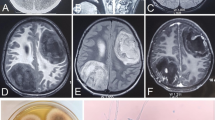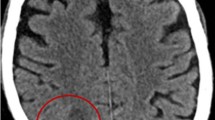Abstract
In the present report, we describe the first case of a phaeohyphomycotic brain abscess in a 5-year-old boy with chronic granulomatous disease (CGD) admitted to hospital with seizures. A computed tomography (CT) scan revealed a cerebral abscess and the microbiology study showed a dark, melanin-pigmented fungus, exhibiting only sterile hyphae. This fungus was identified by the amplification and sequencing of the 5.8S RNA gene and of the adjacent internal transcriber spacer domains, ITS1 and ITS2, as Alternaria infectoria. Due to the impossibility of a surgical excision, and although several therapeutic strategies were attempted, the patient died. Limitations in the routine identification procedures and therapeutic options of this emerging opportunistic agent are highlighted in this report.



Similar content being viewed by others
References
Assari T (2006) Chronic Granulomatous Disease; fundamental stages in our understanding of CGD. Med Immunol 5:1–8. doi:10.1186/1476-9433-5-4
Carneiro-Sampaio M, Coutinho A (2007) Immunity to microbes: lessons from primary immunodeficiencies. Infect Immun 75:1545–1555. doi:10.1128/IAI.00787-06
Alsultan A, Williams MS, Lubner S, Goldman FD (2006) Chronic granulomatous disease presenting with disseminated intracranial aspergillosis. Pediatr Blood Cancer 47:107–110. doi:10.1002/pbc.20426
de Hoog GS, Horré R (2002) Molecular taxonomy of the Alternaria and Ulocladium species from humans and their identification in the routine laboratory. Mycoses 45:259–276. doi:10.1046/j.1439-0507.2002.00747.x
Gilaberte M, Bartralot R, Torres JM, Reus FS, Rodríguez V, Alomar A, Pujol RM (2005) Cutaneous alternariosis in transplant recipients: clinicopathologic review of 9 cases. J Am Acad Dermatol 52:653–659. doi:10.1016/j.jaad.2004.10.875
Dubois D, Pihet M, Clec’h CL, Croué A, Beguin H, Bouchara JP, Chabasse D (2005) Cutaneous phaeohyphomycosis due to Alternaria infectoria. Mycopathologia 160:117–123. doi:10.1007/s11046-005-5259-5
Vieira AP, Vasconcelos J, Fernandes JC, Antunes H, Sousa Basto A, Macedo C, Zaman A, Santos E, Castro Melo J, Roos D (2004) Lymphadenopathy after BCG vaccination in a child with chronic granulomatous disease. Pediatr Dermatol 21:646–651. doi:10.1111/j.0736-8046.2004.21606.x
de Hoog GS, Guarro J, Gené J, Figueras MJ (2000) Atlas of clinical fungi, 2nd edn. Centraalbureau voor Schimmelcultures, Utrecht, The Netherlands and Universitat Rovira i Virgili, Reus, Spain, 1126 pp
Gallelli B, Viviani M, Nebuloni M, Marzano AV, Pozzi C, Messa P, Fogazzi GB (2006) Skin infection due to Alternaria species in kidney allograft recipients: report of a new case and review of the literature. J Nephrol 19:668–672
Vieira R, Veloso J, Afonso A, Rodrigues A (2006) Cutaneous alternariosis in a liver transplant recipient. Rev Iberoam Micol 23:107–109
Ara M, Aspiroz C, Zaballos P, Alcalde V, Alvarez R, Rezusta A, Giménez JA (2006) Relapse of cutaneous Alternaria infectoria in a renal transplant recipient after 2 years. Acta Derm Venereol 86:154–155
Lo Cascio G, Ligozzi M, Maccacaro L, Fontana R (2004) Utility of molecular identification in opportunistic mycotic infections: a case of cutaneous Alternaria infectoria infection in a cardiac transplant recipient. J Clin Microbiol 42:5334–5336. doi:10.1128/JCM.42.11.5334-5336.2004
Nulens E, De Laere E, Vandevelde H, Hilbrands LB, Rijs AJ, Melchers WJ, Verweij PE (2006) Alternaria infectoria phaeohyphomycosis in a renal transplant patient. Med Mycol 44:379–382. doi:10.1080/13693780500412004
Ferrer C, Montero J, Alió JL, Abad JL, Ruiz-Moreno JM, Colom F (2003) Rapid molecular diagnosis of posttraumatic keratitis and endophthalmitis caused by Alternaria infectoria. J Clin Microbiol 41:3358–3360. doi:10.1128/JCM.41.7.3358-3360.2003
Halaby T, Boots H, Vermeulen A, van der Ven A, Beguin H, Van Hooff H, Jacobs J (2001) Phaeohyphomycosis caused by Alternaria infectoria in a renal transplant recipient. J Clin Microbiol 39:1952–1955. doi:10.1128/JCM.39.5.1952-1955.2001
Laumaillé C, Le Gall F, Degeilh B, Guého E, Huerre M (1998) Cutaneous Alternaria infectoria infection after liver transplantation. Ann Pathol 18:192–194
Gerdsen R, Uerlich M, De Hoog GS, Bieber T, Horré R (2001) Sporotrichoid phaeohyphomycosis due to Alternaria infectoria. Br J Dermatol 145:484–486. doi:10.1046/j.1365-2133.2001.04382.x
Brasch J, Busch J-O, de Hoog GS (2008) Cutaneous phaeohyphomycosis caused by Alternaria infectoria. Acta Derm Venereol 88:160–161. doi:10.2340/00015555-0332
Horré R, de Hoog GS (1999) Primary cerebral infections by melanized fungi: a review. Stud Mycol 43:176–193
Carpenter J, Stapleton S, Holliman R (2007) Retrospective analysis of 49 cases of brain abscess and review of the literature. Eur J Clin Microbiol Infect Dis 26:1–11. doi:10.1007/s10096-006-0236-6
Revankar SG, Sutton DA, Rinaldi MG (2004) Primary central nervous system phaeohyphomycosis: a review of 101 cases. Clin Infect Dis 38:206–216. doi:10.1086/380635
Castagnola E, Machetti M, Cappelli B, Molinari AC, Morreale G, Dodero P, Tomà P, Faraci M (2004) Caspofungin associated with liposomal amphotericin B or voriconazole for treatment of refractory fungal pneumonia in children with acute leukaemia or undergoing allogeneic bone marrow transplant. Clin Microbiol Infect 10:255–257. doi:10.1111/j.1198-743X.2004.00837.x
Colombo AL, Rosas RC (2003) Successful treatment of an Aspergillus brain abscess with caspofungin: case report of a diabetic patient intolerant of amphotericin B. Eur J Clin Microbiol Infect Dis 22:575–576. doi:10.1007/s10096-003-0991-6
Author information
Authors and Affiliations
Corresponding author
Rights and permissions
About this article
Cite this article
Hipolito, E., Faria, E., Alves, A.F. et al. Alternaria infectoria brain abscess in a child with chronic granulomatous disease. Eur J Clin Microbiol Infect Dis 28, 377–380 (2009). https://doi.org/10.1007/s10096-008-0623-2
Received:
Accepted:
Published:
Issue Date:
DOI: https://doi.org/10.1007/s10096-008-0623-2




